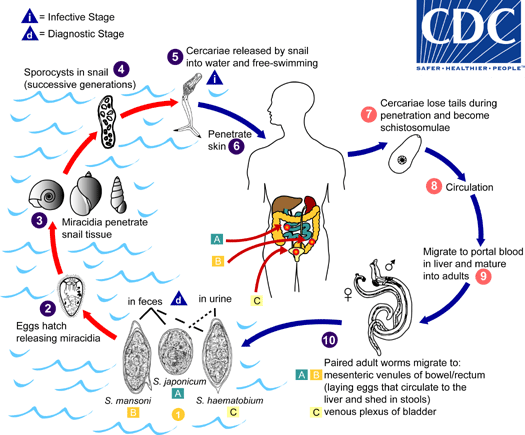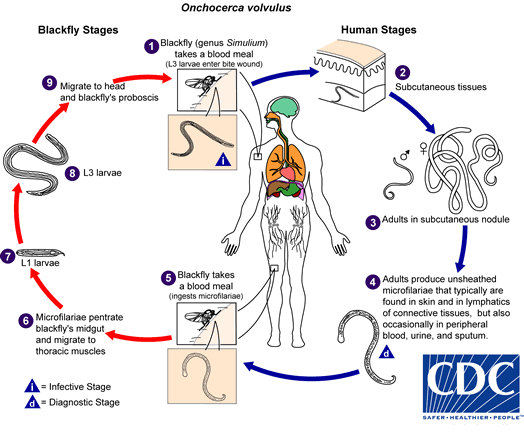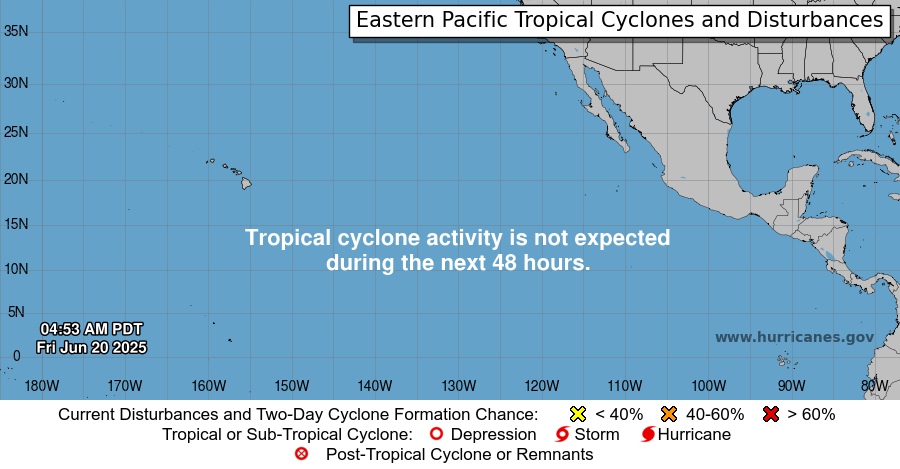Archive for August, 2018
8/31/1886: Near Charleston, South Carolina, an earthquake, felt as far away as Boston and Cuba, leaves more than 100 people dead and hundreds of buildings destroyed.
Friday, August 31st, 2018France: 2 families who had never left Europe have developed schistosomiasis
Friday, August 31st, 2018- Epidemiologists traced the cases to the Cavu River on Corsica.
- Schistosomiasis infects an estimated 230 million people.
- The world’s most widespread parasitic disease after malaria.


Eggs are eliminated with feces or urine  . Under optimal conditions the eggs hatch and release miracidia
. Under optimal conditions the eggs hatch and release miracidia  , which swim and penetrate specific snail intermediate hosts
, which swim and penetrate specific snail intermediate hosts  . The stages in the snail include 2 generations of sporocysts
. The stages in the snail include 2 generations of sporocysts  and the production of cercariae
and the production of cercariae  . Upon release from the snail, the infective cercariae swim, penetrate the skin of the human host
. Upon release from the snail, the infective cercariae swim, penetrate the skin of the human host  , and shed their forked tail, becoming schistosomulae
, and shed their forked tail, becoming schistosomulae  . The schistosomulae migrate through several tissues and stages to their residence in the veins (
. The schistosomulae migrate through several tissues and stages to their residence in the veins (  ,
,  ). Adult worms in humans reside in the mesenteric venules in various locations, which at times seem to be specific for each species
). Adult worms in humans reside in the mesenteric venules in various locations, which at times seem to be specific for each species  . For instance, S. japonicum is more frequently found in the superior mesenteric veins draining the small intestine
. For instance, S. japonicum is more frequently found in the superior mesenteric veins draining the small intestine  , and S. mansoni occurs more often in the superior mesenteric veins draining the large intestine
, and S. mansoni occurs more often in the superior mesenteric veins draining the large intestine  . However, both species can occupy either location, and they are capable of moving between sites, so it is not possible to state unequivocally that one species only occurs in one location. S. haematobium most often occurs in the venous plexus of bladder
. However, both species can occupy either location, and they are capable of moving between sites, so it is not possible to state unequivocally that one species only occurs in one location. S. haematobium most often occurs in the venous plexus of bladder  , but it can also be found in the rectal venules. The females (size 7 to 20 mm; males slightly smaller) deposit eggs in the small venules of the portal and perivesical systems. The eggs are moved progressively toward the lumen of the intestine (S. mansoni and S. japonicum) and of the bladder and ureters (S. haematobium), and are eliminated with feces or urine, respectively
, but it can also be found in the rectal venules. The females (size 7 to 20 mm; males slightly smaller) deposit eggs in the small venules of the portal and perivesical systems. The eggs are moved progressively toward the lumen of the intestine (S. mansoni and S. japonicum) and of the bladder and ureters (S. haematobium), and are eliminated with feces or urine, respectively  . Pathology of S. mansoni and S. japonicum schistosomiasis includes: Katayama fever, hepatic perisinusoidal egg granulomas, Symmers’ pipe stem periportal fibrosis, portal hypertension, and occasional embolic egg granulomas in brain or spinal cord. Pathology of S. haematobium schistosomiasis includes: hematuria, scarring, calcification, squamous cell carcinoma, and occasional embolic egg granulomas in brain or spinal cord.Human contact with water is thus necessary for infection by schistosomes. Various animals, such as dogs, cats, rodents, pigs, hourse and goats, serve as reservoirs for S. japonicum, and dogs for S. mekongi.
. Pathology of S. mansoni and S. japonicum schistosomiasis includes: Katayama fever, hepatic perisinusoidal egg granulomas, Symmers’ pipe stem periportal fibrosis, portal hypertension, and occasional embolic egg granulomas in brain or spinal cord. Pathology of S. haematobium schistosomiasis includes: hematuria, scarring, calcification, squamous cell carcinoma, and occasional embolic egg granulomas in brain or spinal cord.Human contact with water is thus necessary for infection by schistosomes. Various animals, such as dogs, cats, rodents, pigs, hourse and goats, serve as reservoirs for S. japonicum, and dogs for S. mekongi.
Ebola in DRC: If responders can’t turn the outbreak around over the next 7 to 10 days, the risk of the disease spreading to more dangerous conflict-ridden areas becomes greater, posing more difficult challenges for health teams.
Thursday, August 30th, 2018Mardi 28 août 2018
- Au total, 112 cas de fièvre hémorragique ont été signalés dans la région, dont 84 confirmés et 28 probables.
- 18 cas suspects sont en cours d’investigation, dont 2 dans la ville de Goma.
- 1 nouveau cas confirmé à Mandima (contact connu).
- Aucun nouveau décès.
- 3 nouvelles personnes guéries.
A new urine diagnostic to detect the parasitic worms that cause river blindness (Onchocerciasis)
Thursday, August 30th, 2018Ryan Shirey, Daniel Globisch, Lisa M Eubanks, Mark S Hixon, Kim D Janda. Non-Invasive Urine Biomarker Lateral Flow Immunoassay for Monitoring Active Onchocerciasis. ACS Infectious Diseases, 2018; DOI: 10.1021/acsinfecdis.8b00163


During a blood meal, an infected blackfly (genus Simulium) introduces third-stage filarial larvae onto the skin of the human host, where they penetrate into the bite wound  . In subcutaneous tissues the larvae
. In subcutaneous tissues the larvae  develop into adult filariae, which commonly reside in nodules in subcutaneous connective tissues
develop into adult filariae, which commonly reside in nodules in subcutaneous connective tissues  . Adults can live in the nodules for approximately 15 years. Some nodules may contain numerous male and female worms. Females measure 33 to 50 cm in length and 270 to 400 μm in diameter, while males measure 19 to 42 mm by 130 to 210 μm. In the subcutaneous nodules, the female worms are capable of producing microfilariae for approximately 9 years. The microfilariae, measuring 220 to 360 µm by 5 to 9 µm and unsheathed, have a life span that may reach 2 years. They are occasionally found in peripheral blood, urine, and sputum but are typically found in the skin and in the lymphatics of connective tissues
. Adults can live in the nodules for approximately 15 years. Some nodules may contain numerous male and female worms. Females measure 33 to 50 cm in length and 270 to 400 μm in diameter, while males measure 19 to 42 mm by 130 to 210 μm. In the subcutaneous nodules, the female worms are capable of producing microfilariae for approximately 9 years. The microfilariae, measuring 220 to 360 µm by 5 to 9 µm and unsheathed, have a life span that may reach 2 years. They are occasionally found in peripheral blood, urine, and sputum but are typically found in the skin and in the lymphatics of connective tissues  . A blackfly ingests the microfilariae during a blood meal
. A blackfly ingests the microfilariae during a blood meal  . After ingestion, the microfilariae migrate from the blackfly’s midgut through the hemocoel to the thoracic muscles
. After ingestion, the microfilariae migrate from the blackfly’s midgut through the hemocoel to the thoracic muscles  . There the microfilariae develop into first-stage larvae
. There the microfilariae develop into first-stage larvae  and subsequently into third-stage infective larvae
and subsequently into third-stage infective larvae  . The third-stage infective larvae migrate to the blackfly’s proboscis
. The third-stage infective larvae migrate to the blackfly’s proboscis  and can infect another human when the fly takes a blood meal
and can infect another human when the fly takes a blood meal  .
.
Puerto Rico: US now estimates that 2,975 people died as a result of the Hurricane Maria and its effects
Wednesday, August 29th, 20188/29/2005: Katrina, the worst natural disaster in the history of the United States, makes landfall near New Orleans.
Wednesday, August 29th, 2018UN: The Korean peninsular and Southeast Asia may be next to report outbreaks of African swine fever after the rapid onset of the deadly pig disease in China
Wednesday, August 29th, 2018Brazil is sending its army to the Venezuelan border to “guarantee law and order” amid an influx of migrants fleeing the crisis-hit country.
Wednesday, August 29th, 2018“…..Millions of Venezuelans have fled their country due to hyperinflation, and food and medicine shortages.
Brazil’s move follows recent border clashes between locals and Venezuelans…..”
What is happening in Venezuela?
- Venezuela is in its fourth year of an economic crisis
- Brought on by a crash in oil prices in 2014.
- Four in five Venezuelans live in poverty
- People queue for hours to buy food
- Others are dying from a lack of medicine.
- Some 2.3 million citizens have fled the country since 2014,







